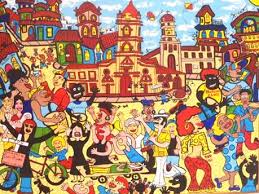The Visual Arts in Cuba from its origins to the present, manifestations and styles

The visual arts encompass a set of disciplines that have as a common denominator a visuality that can be called fixed—conventionally, since contemporary creation increasingly challenges theoretical reductionism—associated with a physical object, whose value may reside in the artistic quality per se or be determined by a practical purpose, for use by an individual or a community, to which artistic features are added. Among their main manifestations we consider the following: painting, sculpture, ceramics, engraving, photography, architecture and graphic design, which emerged and differentiated in dissimilar historical and social contexts, but based on a common heritage interacting in culture.
In the history of the island’s visual arts, the symbols of the indigenous and “imported” universes converge with the combination of colonization and slavery, which entailed the introduction of the Spanish strain of European art (in turn influenced by the centuries-old period in which the peninsula remained under Muslim rule) and African culture with its distinctive symbolism and imagery. Its origins lie in objects of everyday, ceremonial, or religious use by the aborigines, primarily the Taíno, including tools, seats, and vessels, crafted in stone, wood, or clay. At the dawn of visual art, the magical-religious purpose was essential, which is why cemíes—aboriginal idols—carved in stone or other materials constitute the center of a belief system that had diverse expressions in the visual realm.
With the Discovery of America, the arrival of the Spanish colonizers, and the founding of the first towns, a radical transformation of the island’s landscape began. Military fortifications, churches with their imagery, decorations, and liturgical objects, as well as the civil constructions that would emerge shortly after, provided the main impetus for these artistic disciplines. The coat of arms of the city of San Cristobal de la Habana and the statue that would later be known as “La Giraldilla” in the Castillo de la Fuerza (Force Castle) are among the first pieces in which art appears as an end in itself, beyond the utilitarian; although these would also fulfill their function on a symbolic level, as a living representation of the city.
From this amalgamation of elements, a uniquely Cuban worldview of the arts slowly began to crystallize, primarily reflected in architecture, essential for the expansion of cities and, with them, so-called civilization; although this practically represented the extermination of the aboriginal people and their culture. Creole style, associated with the emergence of a nascent bourgeoisie as a social class, began to prevail in Cuba before the nation existed, but the island was considered an overseas province of Spain. In the 18th century, the so-called Cuban Baroque style predominated in architecture, although it was not as richly decorated as the Spanish style, due to the characteristics of the stone worked at the time. The enlightened despotism that characterized the Spanish Crown during this period brought a significant boost to the arts and culture in general. The first theater on the island, “El Coliseo,” was built on Alameda de Paula, already inserted in this architectural style, and churches dating from the period, such as the Havana Cathedral, possess distinctive characteristics, particularly in cornices and columns.
Cuban painting, with the aforementioned cultural background, has its first exponent in Nicolás de la Escalera. In general terms, religious imagery, portraiture, and, soon after, the island’s natural landscape constituted the main themes during the first centuries of Spanish colonization, an aspect that will be addressed in other sections. The founding of the San Alejandro Academy in 1818 represented a milestone in the evolution of this discipline. Furthermore, engraving techniques were fundamentally associated with the tobacco trade; the rings placed on cigars and the packaging or boxes, increasingly elaborated from an artistic point of view, constitute an important precursor to advertising.
In the 20th century, with the advent of the Republic, a group of painters and sculptors who had been disciples of or were in some way connected to the aesthetic principles of the San Alejandro School, where academicism played an important role, developed their work. Names such as Víctor Manuel, Carlos Enrique, Fidelio Ponce de León, Mariano Rodríguez, and René Portocarrero, among others equally important, displayed their visual work during this period, often to the incomprehension of their contemporaries. The North American influence is felt, primarily in advertising, which was not always conceived entirely from artistic principles.
With the triumph of the Cuban Revolution on January 1, 1959, the fabric of the island’s international relations changed, and the Soviet Union largely became a symbol of society and culture. At the same time, and in line with Eastern European concepts, art sought to bear witness to the social transformations taking place and to reach out to the people. This represented a shift in aesthetic direction, opening up new spaces for creation in the visual arts but closing down equally valid ones. The founding of cultural institutions such as UNEAC (National Union of Writers and Artists of Cuba) allowed for a wider dissemination of visual works, but at times there was a harmful subordination of art to political propaganda, particularly in the 1960s and 1970s. After the Special Period and the disenchantment that prevailed in the 1990s, also reflected in the field of visual arts, contemporary artists are turning to installations, audience participation, Pop Art, and other approaches that demonstrate greater aesthetic freedom.








